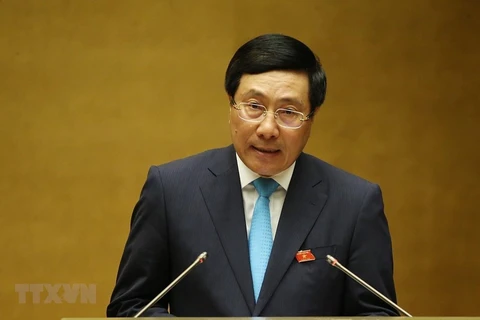Hanoi (VNA) – Vietnam should prioritise using development assistance to strengthen the financial sector, according to Donald Lambert, Principal Private Sector Development Specialist, Southeast Asia Department of the Asian Development Bank (ADB), who also recommended three strategies for Vietnam to achieve its ambitious development goals in the next five years.
Vietnam among world’s fastest growing economies
Donald Lambert said in 2015, Vietnam was the fifth largest recipient of official development assistance (ODA) and qualified for some of the most concessional assistance from the ADB and other donors.
“The story is different now. In 2018, Vietnam's per capita income increased at a compound annual growth rate of 6.3 percent, making Vietnam one of the fastest growing economies in the world. Vietnam has now firmly established its status as a middle-income country and one of the most attractive destinations for foreign direct investment.”
However, he noted that this success also means that donors will start to allocate grants and other concessional funds to countries with more urgent needs. This has been going on. In 2017, Vietnam “graduated” from the World Bank’s concessional country classification and 18 months later from the ADB’s equivalent grouping.
The ADB and other donors have been trying to cushion this transition by blending grants with its lending to Vietnam to reduce net borrowing costs. Additionally, in 2019, it approved a new pricing policy that provided a temporary benefit to countries, like Vietnam, that are recent graduates from the most concessional assistance. Although it is helpful, these measures are temporary and inherently limited and will not provide the funding paradigm for Vietnam’s next socio-economic development plan as previously.
Moreover, these funding needs are significant, Lamber said, adding the ADB estimated that Southeast Asia will need to invest on average 210 billion USD in infrastructure per year through 2030. Vietnam will require a large portion of the 110 billion USD between 2021 and 2025 for infrastructure and to meet the Sustainable Development Goals.
He forecast that 22 billion USD over five years is a big number but it is not insurmountable. “In fact, Vietnam is in a better position than many other countries. While the Philippines, India, and other Asian countries have privately funded a large portion of their infrastructure, the private sector has historically only funded 10 percent of Vietnam’s infrastructure. That means there is a lot of scope for Vietnam - particularly given its compelling growth story - to attract more infrastructure investment.”
Three strategic recommendations
Given the above situation, Lambert put forth three strategic recommendations that will help Vietnam promote economic growth in the coming years.
The first is to use more catalysts for development assistance. This requires a different mindset. Vietnam is no longer a low-income country, but it is not ready to fund itself through private investment and domestic capital markets. A transition period is needed as Vietnam uses donor assistance to catalyse private investment, and without it, private investment would not come by itself.
Nevertheless, this transition period will require new tools. This includes issuing counter-guarantees to the ADB and other development partners so they can use their strong international credit ratings to reduce risks for projects.
In addition, Vietnam should also prioritise development assistance to strengthen the financial sector, providing stand-by facilities or other enhancements to make it easier for state-owned enterprises (SOEs) tasked with key projects to access affordable financing, while allowing development partners to issue VND-linked bonds to lower the cost of capital for Vietnamese borrowers.
Using development assistance catalytically to attract private investment closely ties to the second priority: Passing a strong law on public-private partnerships (PPP). The National Assembly has already considered a first draft of the bill and hopes to pass a second version in May.
The final strategic priority is better mobilisation of domestic capital. The passage of the new Securities Law in November 2019 was a good step as are recent regulatory changes that encourage companies to turn to the bond market instead of banks to fund long-term obligations.
However, Lambert said, more is needed. Vietnam needs to establish a domestic credit rating agency, and the government should actively market this investment opportunity to leading international rating agencies. These steps will help the corporate bond market evolve, eventually creating opportunities for project bonds, particularly if credit enhancement mechanisms are available for these instruments./.

























